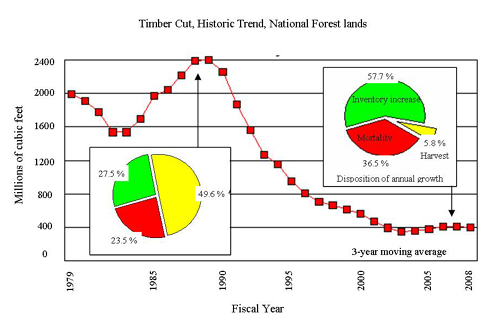National Forest Timber Management: Myth, reality, and some questions for the future
by W.V. (Mac) McConnell, U.S.F.S. Retired (1943-1973)
Timber harvesting from National Forest land, the single largest timberland holding in the nation, has decreased by some 80% over the past two decades. The impacts of this decline have been far-reaching and well documented. Insect epidemics, fire hazard, fire frequency, and fire control expenditures have increased hugely. Community dislocation, business closures, job losses, and school and local government distress are widespread.
While the fact of the decline is widely known, the public would seem to have little understanding of the relationship of harvesting to forest growth, mortality, and the realities of management and forest health. The widespread misconception that the Forest Service was “overharvesting” the timber on the National Forests contributed to the demand, led by environmental activists, that the Forest Service reduce, or eliminate entirely, commercial harvesting of timber from its lands. This image of a national resource being decimated by a rapacious timber industry was a far cry from actuality. The record shows that at the apex of harvesting the agency cut each year only 50% of the gross annual growth, while the equivalent of about a quarter of the volume grown died and slightly more was added to the inventory of standing trees.

In contrast, today the Forest Service is harvesting only 6% of the growth (a remarkably low figure) while 36% dies, adding to the fuel loading and increasing fire hazards and suppression costs. The remaining 58% of the growth is added each year to the existing volume, resulting in over-dense, fire-prone stands and deteriorating wildlife habitat.
Although the emphasis has been on correcting past mistakes by reducing the volume of the cut, the problems seen by environmentalists and others of the concerned public stemmed not from the “quantity” of the harvest but from the its “quality”. Extensive (and unsightly) clearcuts on unstable slopes, logging on unsuitable terrain and of heritage stands of patriarch trees, failure to use Best Management Practices with resultant harm to soil, water, and aesthetic resources, reluctance to implement the imperatives of the Endangered Species Act — all have contributed to the public demand for a more restrictive approach to timber management on public lands. The Forest Service’s and industry’s belated recognition and correction of many of these errors came too late and the perception of the Agency as permanently favoring timber as the “best among equals” now appears to be embedded as dogma in a large part the environmental community. This view may be the single most important impediment to balanced resource management on our National Forests.
Is current National Forest timber management making its optimum contribution to the “Greatest good for the greatest number in the long run”? Does the current ratio of growth/harvest/mortality represent sound forest management? Should this ratio be changed? In what way? Can it be changed? How do you answer these questions?
by Forrest Grump

Part of it is going to have to be logic. You can’t Pile Higher and Deeper forever.
One step is happening here, as “we” are on the angle that a fire’s cost is NOT just fighting it, it’s the attributes lost, including wood, but not exclusively. At some point it is going to be up to the sane side of the forestry debate to package a program on an avoided-cost basis.
The dumb growth crowd uses it all the time… by saying banning such and such and so and so means the gummint spends less, therefore ban it. In their case, the use is dishonest and illogical. But being able to describe how spending XX on fuels management (call it restoration) will prevent xx plus xx plus xx in avoidable loss is something that should, and will happen.
Save Trees. Save the Forest. Save Money Too.